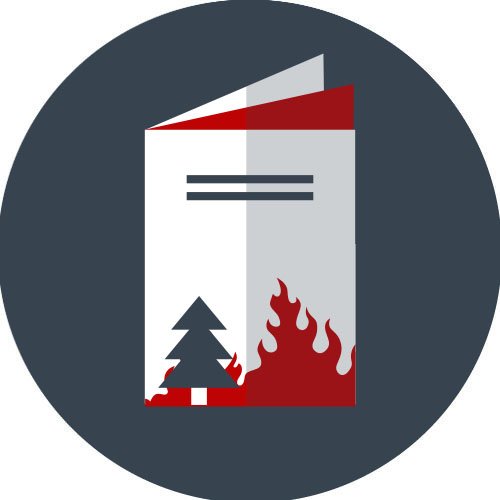PREPAREDNESS
Your wildfire emergency plan must be prepared well in advance of a fire and shared with all members of your household. Use these checklists to help you prepare your family for a wildfire emergency.
YOUR WILDFIRE EMERGENCY PLAN
One of the first steps you should take in preparing for wildfire is to Create a Family Wildfire Emergency Plan.
Include meeting locations and communication plans and rehearse your emergency plan regularly.
Your plan should include family pets as well as the evacuation of any large animals such as horses.
Have fire extinguishers on hand and train your family how to use them.
Ensure that your family knows where your gas, electric and water main shut-off controls are and how to use them.
Plan several different evacuation routes.
Designate an emergency meeting location outside the fire hazard area.
Assemble an emergency supply kit as recommended by the American Red Cross.
Appoint an out-of-area friend or relative as a point of contact so you can communicate with family members who have relocated.
Maintain a list of emergency contact numbers posted near your phone and in your emergency supply kit.
Keep an extra emergency supply kit in your car in case you can’t get to your home because of fire.
Have a portable radio or scanner so you can stay updated on the fire.
YOUR EMERGENCY GO KIT
The American Red Cross recommends every family have an emergency go kit assembled long before a wildland fire or other emergency occurs. Use this checklist to help assemble yours. For more information on emergency supplies, visit the American Red Cross website.
INCLUDE IN YOUR EMERGENCY GO KIT:
Three-day supply of water (one gallon per person per day)
Non-perishable food for all family members and pets (three-day supply)
First aid kit
Flashlight, battery-powered radio, and extra batteries
An extra set of car keys, credit cards, cash, or traveler’s checks
Sanitation supplies
Extra eyeglasses or contact lenses
Important family documents and contact numbers
Map marked with evacuation routes
Prescriptions or special medications
Family photos and other irreplaceable items
Easily carried valuables
Personal computers (information on hard drives and disks)
Chargers for cell phones, laptops, etc.
Note: Keep a pair of old shoes and a flashlight handy in case of a sudden evacuation at night.
WHEN A FIRE STARTS
Evacuate as soon as you are told to evacuate or immediately if you feel unsafe.
Alert family and neighbors.
Dress in appropriate clothing (i.e., clothing made from natural fibers, such as cotton, and work boots). Have goggles and a dry bandana or particulate mask handy.
Ensure that you have your emergency supply kit on hand.
Check your phone or computer for emergency notifications from Pitkin Alert.
Stay tuned to your TV or local radio stations for updates.
Remain close to your house, drink plenty of water and keep an eye on your family and pets until you are ready to leave.
INSIDE CHECKLIST
Shut all windows and doors, leaving them unlocked.
Remove flammable window shades and curtains and close metal shutters.
Move flammable furniture to the center of the room, away from windows and doors.
Shut off gas at the meter. Turn off pilot lights.
Leave your lights on so firefighters can see your house under smoky conditions.
Shut off the air conditioning.
OUTSIDE CHECKLIST
Gather up flammable items from the exterior of the house and bring them inside (e.g., patio furniture, children’s toys, door mats, etc.).
Turn off propane tanks.
Don’t leave sprinklers on or water running. They can waste critical water pressure.
Leave exterior lights on.
Back your car into the driveway.
Shut doors and roll up windows.
Have a ladder available.
Patrol your property and extinguish all small fires until you leave.
Seal attic and ground vents with pre-cut plywood or commercial seals if time permits.
IF YOU ARE TRAPPED: SURVIVAL TIPS
Shelter away from outside walls.
Bring garden hoses inside house so embers don’t destroy them.
Patrol inside your home for spot fires and extinguish them.
Wear long sleeves and long pants made of natural fibers such as cotton.
Stay hydrated.
Ensure you can exit the home if it catches fire. Remember if it’s hot inside the house, it is four to five times hotter outside.
Fill sinks and tubs for an emergency water supply.
Place wet towels under doors to keep smoke and embers out.
After the fire has passed, check your roof, and extinguish any fires, sparks or embers.
Check inside the attic for hidden embers.
Patrol your property and extinguish small fires. If there are fires that you cannot extinguish with a small amount of water or in a short period of time, call 9-1-1.
WHEN TO LEAVE
Leave early enough to avoid being caught in fire, smoke, or road congestion.
Don’t wait to be told by authorities to leave. In an intense wildland fire, they may not have time to knock on every door.
By leaving early, you give your family the best chance of surviving a wildland fire. You also help firefighters by keeping roads clear of congestion, enabling them to move more freely and do their job in a safer environment.
WHERE TO GO
Leave to a predetermined location. It should be a low-risk area, such as a well-prepared neighbor or relative’s house, a Red Cross shelter or evacuation center, motel, etc.
HOW TO GET THERE
Have several travel routes in case one route is blocked by the fire or by emergency vehicles and equipment. Choose an escape route away from the fire.
EMERGENCY ALERTS
Pitkin Alert is an emergency notification system that alerts residents and business owners through text messages, email, cell or land line phones. In the event of a wildfire incident, Pitkin Alert will send you up-to-date notifications about the fire, associated road closures and evacuation orders. You must register for the free alerts at PitkinAlert.org.
WILDFIRE ACTION GUIDE
PREPAREDNESS WORKBOOK FOR PEOPLE WITH DISABILITIES










